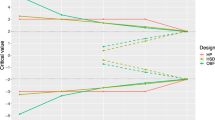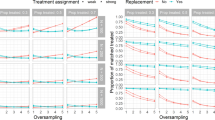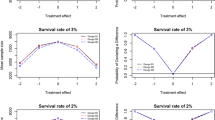Abstract
Objectives
Operative clinical trials are often small and open-label. Randomization is therefore very important. Stratification and minimization are two randomization options in such trials. The first aim of this study was to compare stratification and minimization in terms of predictability and balance in order to help investigators choose the most appropriate allocation method. Our second aim was to evaluate the influence of various parameters on the performance of these techniques.
Materials and methods
The created software generated patients according to chosen trial parameters (e.g., number of important prognostic factors, number of operators or centers, etc.) and computed predictability and balance indicators for several stratification and minimization methods over a given number of simulations. Block size and proportion of random allocations could be chosen. A reference trial was chosen (50 patients, 1 prognostic factor, and 2 operators) and eight other trials derived from this reference trial were modeled. Predictability and balance indicators were calculated from 10,000 simulations per trial.
Results
Minimization performed better with complex trials (e.g., smaller sample size, increasing number of prognostic factors, and operators); stratification imbalance increased when the number of strata increased. An inverse correlation between imbalance and predictability was observed.
Conclusions
A compromise between predictability and imbalance still has to be found by the investigator but our software (HERMES) gives concrete reasons for choosing between stratification and minimization; it can be downloaded free of charge.
Clinical relevance
This software will help investigators choose the appropriate randomization method in future two-arm trials.





Similar content being viewed by others
Notes
This software can be downloaded at the following address: chabouis.fr/helene/hermes
We could also do a simple sum of the absolute imbalance values, but this method allowed us to penalize more serious imbalances. [39]
References
Altman DG, Bland JM (1999) Statistics notes. Treatment allocation in controlled trials: why randomise? BMJ 318(7192):1209
Pihlstrom BL, Barnett ML (2010) Design, operation, and interpretation of clinical trials. J Dent Res 89(8):759–772. doi:10.1177/0022034510374737
Pandis N, Polychronopoulou A, Eliades T (2010) An assessment of quality characteristics of randomised control trials published in dental journals. J Dent 38(9):713–721. doi:10.1016/j.jdent.2010.05.014
D'Agostino RB, Sr. and Massaro JM (2004) New developments in medical clinical trials. J Dent Res 83 Spec No C:C18-24
Pandis N, Polychronopoulou A, Eliades T (2011) Randomization in clinical trials in orthodontics: its significance in research design and methods to achieve it. Eur J Orthod. doi:10.1093/ejo/cjq141
Pocock SJ, Assmann SE, Enos LE, Kasten LE (2002) Subgroup analysis, covariate adjustment, and baseline comparisons in clinical trial reporting: current practice and problems. Stat Med 21(19):2917–2930. doi:10.1002/sim.1296
Altman DG (1991) Randomisation. BMJ 302(6791):1481–1482
Halpern J, Brown BW Jr (1986) Sequential treatment allocation procedures in clinical trials—with particular attention to the analysis of results for the biased coin design. Stat Med 5(3):211–229
Watson HR, Pearce AC (1990) Treatment allocation in clinical trials: randomisation and minimisation compared in three test cases. Pharmaceutical Medicine 4(3):207–212
ICH Harmonised Tripartite Guideline, Statistical principles for clinical trials, International Conference on Harmonisation E9 Expert Working Group (1999) Stat Med 18(15):1905–1942
Buyse M (2000) Centralized treatment allocation in comparative clinical trials. Applied Clinical Trials 9:32–37
Green H, McEntegart DJ, Byrom B, Ghani S, Shepherd S (2001) Minimization in crossover trials with non-prognostic strata: theory and practical application. J Clin Pharm Ther 26(2):121–128
McEntegart D (2003) The pursuit of balance using stratified and dynamic randomization techniques: an overview. Drug Information Journal 37:293–308
Assmann SF, Pocock SJ, Enos LE, Kasten LE (2000) Subgroup analysis and other (mis)uses of baseline data in clinical trials. Lancet 355(9209):1064–1069. doi:10.1016/S0140-6736(00)02039-0
Committee for Proprietary Medicinal Products (CPMP), Points to consider on adjustment for baseline covariates (2004) Stat Med 23(5):701–709. doi:10.1002/sim.1647
Treasure T, MacRae KD (1998) Minimisation: the platinum standard for trials? Randomisation doesn’t guarantee similarity of groups; minimisation does. BMJ 317(7155):362–363
Rovers MM, Straatman H, Zielhuis GA, Ingels K, van der Wilt GJ (2000) Using a balancing procedure in multicenter clinical trials. Simulation of patient allocation based on a trial of ventilation tubes for otitis media with effusion in infants. Int J Technol Assess Health Care 16(1):276–281
Peto R, Pike MC, Armitage P, Breslow NE, Cox DR, Howard SV, Mantel N, McPherson K, Peto J, Smith PG (1976) Design and analysis of randomized clinical trials requiring prolonged observation of each patient. I. Introduction and design. Br J Cancer 34(6):585–612
Nam JM (1995) Sample size determination in stratified trials to establish the equivalence of two treatments. Stat Med 14(18):2037–2049
Kernan WN, Viscoli CM, Makuch RW, Brass LM, Horwitz RI (1999) Stratified randomization for clinical trials. J Clin Epidemiol 52(1):19–26
Altman DG, Bland JM (1999) How to randomise. BMJ 319(7211):703–704
Efron B (1971) Forcing a sequential experiment to be balanced. Biometrika 58(1971):403–417
Wei LJ (1977) A class of designs for sequential clinical trials. J Am Stat Assoc 72:382–386
Soares JF, Wu CF (1983) Some restricted randomization rules in sequential designs. Communications in statistics—theory and methods 12:2017–2034
Signorini DF, Leung O, Simes RJ, Beller E, Gebski VJ, Callaghan T (1993) Dynamic balanced randomization for clinical trials. Stat Med 12(24):2343–2350
Altman DG, Bland JM (2005) Treatment allocation by minimisation. BMJ 330(7495):843. doi:10.1136/bmj.330.7495.843
Therneau TM (1993) How many stratification factors are “too many” to use in a randomization plan? Control Clin Trials 14(2):98–108
Taves DR (1974) Minimization: a new method of assigning patients to treatment and control groups. Clin Pharmacol Ther 15(5):443–453
Pocock SJ, Simon R (1975) Sequential treatment assignment with balancing for prognostic factors in the controlled clinical trial. Biometrics 31(1):103–115
Brown S, Thorpe H, Hawkins K, Brown J (2005) Minimization—reducing predictability for multi-centre trials whilst retaining balance within centre. Stat Med 24(24):3715–3727. doi:10.1002/sim.2391
Altman DG, Schulz KF, Moher D, Egger M, Davidoff F, Elbourne D, Gotzsche PC, Lang T (2001) The revised CONSORT statement for reporting randomized trials: explanation and elaboration. Ann Intern Med 134(8):663–694
Weir CJ, Lees KR (2003) Comparison of stratification and adaptive methods for treatment allocation in an acute stroke clinical trial. Stat Med 22(5):705–726. doi:10.1002/sim.1366
Toorawa R, Adena M, Donovan M, Jones S, Conlon J (2009) Use of simulation to compare the performance of minimization with stratified blocked randomization. Pharm Stat 8(4):264–278. doi:10.1002/pst.346
Kundt G (2009) Comparative evaluation of balancing properties of stratified randomization procedures. Methods Inf Med 48(2):129–134. doi:10.3414/ME0538
Birkett NJ (1985) Adaptive allocation in randomized controlled trials. Control Clin Trials 6(2):146–155
Zhao W, Weng Y, Wu Q, Palesch Y (2012) Quantitative comparison of randomization designs in sequential clinical trials based on treatment balance and allocation randomness. Pharm Stat 11(1):39–48. doi:10.1002/pst.493
Verberk WJ, Kroon AA, Kessels AG, Nelemans PJ, Van Ree JW, Lenders JW, Thien T, Bakx JC, Van Montfrans GA, Smit AJ, Beltman FW, De Leeuw PW (2005) Comparison of randomization techniques for clinical trials with data from the HOMERUS-trial. Blood Press 14(5):306–314. doi:10.1080/08037050500331538
Hagino A, Hamada C, Yoshimura I, Ohashi Y, Sakamoto J, Nakazato H (2004) Statistical comparison of random allocation methods in cancer clinical trials. Control Clin Trials 25(6):572–584. doi:10.1016/j.cct.2004.08.004
Scott NW, McPherson GC, Ramsay CR, Campbell MK (2002) The method of minimization for allocation to clinical trials. A review. Control Clin Trials 23(6):662–674
Hills R, Gray R, Wheatley K (2003) High probability of guessing next treatment allocation with minimisation by clinician. Control Clin Trials 24(suppl 3S):70S
McPherson G, Campbell M, Elbourne D (2003) Minimisation: predictability versus imbalance. Control Clin Trials 24:133S
Hanley JA, McNeil BJ (1982) The meaning and use of the area under a receiver operating characteristic (ROC) curve. Radiology 143(1):29–36
Simon R (1979) Restricted randomization designs in clinical trials. Biometrics 35(2):503–512
Lachin JM, Matts JP, Wei LJ (1988) Randomization in clinical trials: conclusions and recommendations. Control Clin Trials 9(4):365–374
Forsythe AB (1987) Validity and power of tests when groups have been balanced for prognostic factors. Computational Statistics and Data Analysis 5:193–200
Kalish LA, Begg CB (1985) Treatment allocation methods in clinical trials: a review. Stat Med 4(2):129–144
Bracken MB (2001) On stratification, minimization, and protection against types 1 and 2 error. J Clin Epidemiol 54(1):104–105
Tu D, Shalay K, Pater J (2000) Adjustment of treatment effect for covariates in clinical trials: statistical and regulatory issues. Drug Inf J 34:511–523
Senn S (1995) A personal view of some controversies in allocating treatment to patients in clinical trials. Stat Med 14(24):2661–2674
Senn SJ (1989) Covariate imbalance and random allocation in clinical trials. Stat Med 8(4):467–475
Ohashi Y (1990) Randomization in cancer clinical trials: permutation test and development of a computer program. Environ Health Perspect 87:13–17
Ross N (1999) Randomised block design is more powerful than minimisation. BMJ 318(7178):263–264
Acknowledgments
The Université Paris Descartes (Sorbonne Paris Cité) provided financial support for this study. We thank the anonymous reviewers who made useful comments and suggestions.
Conflict of interest
The authors declare that they have no conflict of interest.
Author information
Authors and Affiliations
Corresponding author
Appendices
Appendix 1
Justification for the number of simulations (10,000) carried out in this study
We aimed to estimate the expected value of a random variable (predictability or imbalance) with n independent realizations (simulations were independent) and identical distribution (patients were simulated in the same proportions). Our indicator was therefore the estimator of the random variable’s expected value. According to the central limit theorem, we know that the standard deviation of our estimator was \( \sqrt{{\frac{{Var\,(X)}}{n}}} \), where n is the number of simulations (here 10,000).
Taking Trial 0 as an example, the precision of our imbalance indicator for deterministic minimization (whose estimated expected value was 0.597 %) was 1.42 %/\( \sqrt{10,000 } \), which is 0.0142 %.
The 95 % confidence interval of our imbalance indicator was therefore 0.597 ± 1.96 × 0.0142, or [0.569 to 0.625]. This level of precision seemed acceptable to compare these methods, and is the reason why we presented the results with one digit after the decimal point.
Appendix 2
How the allocation method impacts the analysis of resulting data
Type of analysis
Tests of statistical inference are based on the assumption of random assignment to treatment and control groups. Only simple randomization has this property, so that distorted p values and concerns over the validity of the analysis surround not just minimization but all other allocation methods [39]. However, the disadvantage of adaptive methods like minimization is that the correct analysis is complex and not clearly worked out [39, 44]. In fact, minimization achieves balance only among the marginal distribution of the strata [25]. Where the outcome measure is a continuous variable, various authors recommend that adjustment should be made for factors in the minimization using analysis of covariance [28, 32, 45]. Several other authors recommend using permutation tests to analyze trials where minimization has been used [43, 46]; however, because these tests are not straightforward in practice and seem to make little difference to the results obtained, some authors believe permutation tests are unnecessary and that a classical analysis will usually yield satisfactory conclusions provided that minimization factors are used as covariates in the analysis [8, 9, 11, 12]. Some authors consider that the nominal significance level in that case should be adjusted [32, 35, 45], whereas Hagino et al. believe this is unnecessary [38]. For both stratified randomization and minimization, the collapsibility of the data should be checked, and if it depends on the statistic used, the tenuousness of the conclusions should be noted [47].
Inclusion of randomization covariates in the analysis
Although scientists may find the results of simple, unadjusted treatment comparisons with demonstration of good balance of important factors more convincing than the results of a covariate analysis, there is a consensus that the prognostic factors included in the randomization scheme should be taken into account in the analysis, not just for minimization [12, 32, 46, 48, 49] but also for stratification [50]. The p value for a difference between endpoint rates in treatment groups would be otherwise overestimated [18, 38, 51].
Effect on the nominal level and the power of the test
Authors in favor of stratified randomization put forward its value in reducing the risk of type I error [20] and increasing power [52], but this advantage is controversial. Some authors believe that both stratification and minimization procedures produce comparable improvements in reducing type I and II error [35]. Tu et al. found that minimization procedures were inferior to stratified allocation in reducing the two types of error, due to existing interactions between covariates [48]. However, other simulations have given opposite results [32, 35, 38].
Rights and permissions
About this article
Cite this article
Fron Chabouis, H., Chabouis, F., Gillaizeau, F. et al. Randomization in clinical trials: stratification or minimization? The HERMES free simulation software. Clin Oral Invest 18, 25–34 (2014). https://doi.org/10.1007/s00784-013-0949-8
Received:
Accepted:
Published:
Issue Date:
DOI: https://doi.org/10.1007/s00784-013-0949-8




